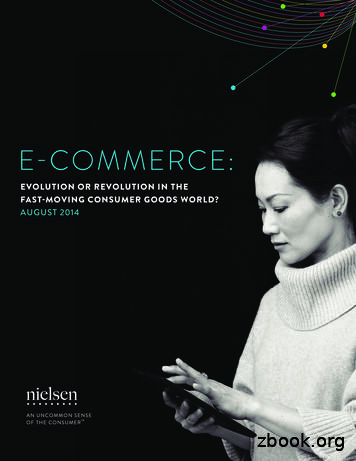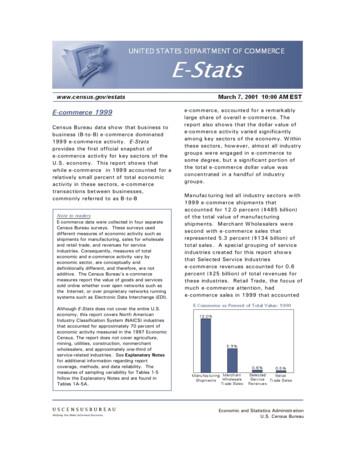Guidelines On E-Commerce Date Extend - Consumer Affairs
1 PageDraftAdvisory to State Governments / Union Territories:Model Framework for Guidelines on e-Commerce forconsumer protectionThese guidelines, may be called the e-Commerce Guidelines for consumer protection 2019.These are issued as guiding principles for e commerce business for preventing fraud, unfairtrade practices and protecting the legitimate rights and interests of consumers.These Guidelines apply to the Business-to-Consumer e-Commerce, including goods andservices, which also include digital contents products (hereafter “goods and services”).1.Short Title & Commencement –(1) These Guidelines may be called the Consumer Protection (e-Commerce) Guidelines,2018.(2) They shall come into force on the date of their publication in the official Gazette.2.Definitions –(1) In these Guidelines unless the context otherwise requires, a."Act" means the Consumer Protection Act, 1986 (68 of 1986)b.“Consumer” shall have the same meaning as provided under the ConsumerProtection Act, 1986 (68 of 1986)c.“E-Commerce entity” means a company incorporated under the Companies Act,1956 or the Companies Act, 2013 or a foreign company covered under section 2 (42) of theCompanies Act, 2013 or an office, branch or agency in India as provided in Section 2 (v) (iii)of FEMA 1999, owned or controlled by a person resident outside India and includes anelectronic service provider or a partnership or proprietary firm, whether inventory or marketplace model or both and conducting the e-Commerce business;Provided that “e-Commerce Entity” does not include any entity or business notifiedotherwise by the Government for the said purpose from time to time.d.“Electronic Record" means data, record or data generated, image or sound stored,received or sent in an electronic form or micro film or computer generated micro fiche; (asper Information Technology Act);
2 Pagee.“Electronic Service Provider” means a person who provides technologies orprocesses to enable a product seller to engage in advertising or selling of goods or servicesto a consumer and includes any online market place or online auction sites;f.“Goods” means goods as defined in the Sale of Goods Act, 1930g.“Inventory based model of e-Commerce” means an e-Commerce activity whereinventory of goods and services is owned by e-Commerce entity and is sold to theconsumers directly;h."Information" includes data, message, text, images, sound, voice, codes, computerprogrammes, software and databases or micro film or computer generated micro fiche; (asper Information Technology Act);i.“Market place model of e-Commerce” means providing of an informationtechnology platform by an e-Commerce entity on a digital & electronic network to act as afacilitator between buyer and seller;k.“Seller” means product seller as defined in the Sale of Goods Act 1930 and includesa Service Provider;l.“Service” means Service as defined in the Consumer Protection Act, 1986;(2) Words and expressions used in these guidelines and not defined but defined in the CPAct shall have the meanings respectively assigned to them in the Act.3.General Conditions for carrying out e-Commerce business(a) Every e-Commerce entity carrying out or intending to carry out e-Commerce business inIndia subsequent to the publication of this notification in the Gazette, shall within 90 dayscomply with the following set of conditions for the conduct of e-Commerce business:i.ii.iii.iv.v.It shall be a registered legal entity under the laws of India;It shall submit a self-declaration to this Department stating that it is in compliance withthese Guidelines;The promoter or key management personnel should not have been convicted of anycriminal offence punishable with imprisonment in last 5 years by any Court ofcompetent jurisdiction;It shall comply with the provisions of Information Technology (Intermediariesguidelines) Rules, 2011.Payments for sale may be facilitated by the e-Commerce entity in conformity with theguidelines of the Reserve Bank of India.vi. Details about the sellers supplying the goods and services, including identity of theirbusiness, legal name, principal geographic address, name of website, e-mail address,
3 Pagecontact details, including clarification of their business identity, the products they sell,and how they can be contacted by customers shall be displayed in the web site.4. Liabilities of E Commerce entityAn E- commerce Entity shall not,i.directly or indirectly influence the price of the goods or services and shall maintain alevel playing field;ii.adopt any trade practice which for the purpose of promoting the sale, use or supplyof any goods or for the provision of any service, or composite supply, adopts anyunfair methods or unfair or deceptive practice that may influence transactionaldecisions of consumers in relation to products and services;iii.falsely represent themselves as consumers or post reviews about goods and servicesin their name; or misrepresent or exaggerate the quality or the features of goods andservices.An E-Commerce Entity shall,i.ii.iii)iv)vi)display terms of contract between e-Commerce entity and the seller relating to return,refund, exchange, warranty / guarantee, delivery / shipment, mode of payments,grievance redressal mechanism etc. to enable consumers to make informeddecisions.ensure that the advertisements for marketing of goods or services are consistent withthe actual characteristics, access and usage conditions of such of goods or services;mention safety and health care information of the goods and service advertised forsale;provide information on available payment methods; the security of those paymentmethods, how to use those methods; how to cancel regular payments under thosemethods; charge back options and any costs applicable to those payment methods;Ensure that personally identifiable information of customers are protected, and thatsuch data collection and storage and use comply with provisions of the InformationTechnology (Amendment) Act, 2008.
4 Pagevii)Accept return of goods if delivered late from the stated delivery schedule or deliveryof defective, wrong or spurious products, and/or not of the characteristics/features asadvertised;viii)Effect all payments towards accepted refund requests of the customers within aperiod of maximum of 14 days.ix)if the ecommerce entity is informed by the consumer or comes to know by itself orthrough another source about any counterfeit product being sold on its platform, andis satisfied after due diligence, it shall notify the seller and if the seller is unable toprovide any evidence that the product is genuine, it shall take down the said listingand notify the consumers of the samex)be held guilty of contributory or secondary liability if it makes an assurance vouchingfor the authenticity of the goods sold on its market place – or if it guarantees thatgoods are authentic.5. Liabilities of Sellers–Any seller selling or advertising his products or services through an e-Commerce platformshall, a)b)c)d)e)f)g)h)have prior written contract with the respective e-Commerce entity in order toundertake or solicit such sale or offer;provide all information required to be provided either by law or by any othermandatory regime for disclosing contractual information and compliance with thatregime will be treated as sufficient;display single-figure total and break up price for the goods or service, that includesall compulsory charges such as delivery, postage, taxes and handling andconveyance charges;comply with mandatory display requirements as per Legal Metrology (amendment)rules 2017 for pre-packaged commodities;provide mandatory safety and health care warnings and shelf life that a consumerwould get at any physical point of sale;Provide fair and reasonable, delivery terms, or to directly reference the shippingpolicy.Be responsible for any warranty/guarantee obligation of goods and services sold.Be upfront about how exchange, returns and refund process works, and who baresthe costs of return shipping.
5 Page6. Consumer grievance redress procedure–Every e-Commerce entity shall,i)Publish on its website the name of the Grievance Officer and his contact details aswell as mechanism by which users can notify their complaints about products andservices availed through their web site.ii)The Grievance Officer shall redress the complaints within one month from the dateof receipt of complaintiii)provide facility to consumers to register their complaints over phone, email or websiteand shall provide complaint number for tracking the complaint;iv)Provide consumers with transparent and effective consumer protection that is notless than the level of protection offered in other forms of commerce;v)Provide mechanism/system to converge with NCH in grievance redress -----------------------------------------------
to a consumer and includes any online market place or online auction sites; f. "Goods" means goods as defined in the Sale of Goods Act, 1930 g. "Inventory based model of e-Commerce" means an e-Commerce activity where inventory of goods and services is owned by e-Commerce entity and is sold to the consumers directly; h.
Pasadena (CA) Chamber of Commerce Paso Robles Chamber of Commerce Perris Valley Chamber of Commerce Petaluma Area Chamber of Commerce . East Haven Chamber of Commerce Fairfield Chamber of Commerce Granby Chamber of Commerce Greater Danbury Chamber of Commerce Greater Hartford BOMA
Jan 09, 2017 · Wallowa County Chamber of Commerce Chamber of Commerce in La Grande, OR Union County, Oregon Chamber of Commerce Nyssa, Oregon Chamber of Commerce Ontario, Oregon Chamber of Commerce Pendleton, Oregon Chamber of Commerce The Dalles, Oregon Chamber of Commerce Vale, Oregon Chamber of Commerce
Green Valley Sahuarita Chamber of Commerce & Visitor Center Lake Havasu Area Chamber of Commerce Marana Chamber of Commerce Mesa Chamber of Commerce Nogales-Santa Cruz County Chamber of Commerce Prescott Chamber of Commerce Prescott Valley Chamber of Commerce Queen Creek
Introduction to e-commerce 1 LEARNING OBJECTIVES c To understand the complexity of e-commerce and its many facets. c To explore how e-business and e-commerce fit together. c To identify the impact of e-commerce. c To recognise the benefits and limitations of e-commerce. c To use classification frameworks for analysing e-commerce.
1.3 Various applications of E-commerce 1.4 Features of E-commerce Technology 1.5 Types of e-commerce 1.6 Impact of e-commerce 1.7 Summary 1.8 Self-Assessment Test 1.9 Suggested Readings 1.1 Introduction E-commerce is buying and selling goods and services over the Internet or doing business online. Commerce is part of e-business as specified in .
M-commerce is the next revolutionary way of doing business after e-commerce, which is set to change the landscape of businesses. The term m-commerce came into existence in 1997 when it was first used by Kevin Duffey at the launch of the Global Mobile Commerce Forum organised in the UK, to mean "the delivery of electronic
E-COMMERCE SHIFTS INTO HIGHER GEAR E-commerce is big business and getting bigger every day. Growth estimates from eMarketer report that business-to-consumer (B2C) e-commerce sales worldwide will reach 1.5 trillion in 2014, increasing nearly 20% over 2013. But not all e-commerce categories are created equal. The most popular e-commerce .
e-commerce activity for key sectors of the U.S. economy. This report shows that while e-commerce in 1999 accounted for a relatively small percent of total economic activity in these sectors, e-commerce transactions between businesses, commonly referred to as B-to-B e-commerce, accounted for a remarkably large share of overall e-commerce. The






















